|
< Earlier Kibitzing · PAGE 2 OF 2 ·
Later Kibitzing> |
| Jun-01-14 | | Dr. J: After 14.Bxh7+ Kxh7 15.Nf3 Qh5 16.Ng5+ Kg6, what does White have? And what about 14.Bxh7+ Kxh7 15.Nf3 Qe7 16.Qg4 f5 (or 16...f6)? Or 14.Bxh7+ Kxh7 15.Nf3 Qg6 16.Nh4 Qh7? |
|
| Jun-01-14 | | morfishine: <14.Ne4> and Black Queen does not have safe square 14.Ne4 Qh4 15.Bg5
14.Ne4 Qg6 15.Nf6+
14.Ne4 Qd8 15.Nf6+ gxf6 16.Bxh7+ Kxh7 17.Qh5+ Kg8 18.Re3 ***** |
|
| Jun-01-14 | | Talis: <Dr. J: After 14.Bxh7+ Kxh7 15.Nf3 Qh5 16.Ng5+ Kg6, what does White have? >
17.Qd3+ f5 18.exf6+ Kxf6 19.Rxe6x. If 17....Kh6, then 18.Qh7x |
|
| Jun-01-14 | | agb2002: White has the bishop pair for a bishop, a knight and a pawn. The position of the black queen invites to play 14.Ne4 to prepare knight and bishop sacrfices on f6 and h7 respectively, paving the way for the queen, king's rook and queen's bishop: A) 14... Qf5(g6) 15.Nf6+ wins the queen for two pieces. B) 14... Qh4 15.Bg5 again wins the queen for two pieces. C) 14... Qe7 15.Nf6+
C.1) 15... gxf6 16.Bxh7+
C.1.a) 16... Kxh7 17.Qh5+ Kg7(8) 18.Qg4+ Kh7(8) 19.Re3 and mating with Rh3. C.1.b) 16... Kh8 17.Qh5 and mate soon (17... Kg7 18.Qh6+ Kh8 19.Bg6+ Kg8 20.Qh7#; 17... fxe5 18.Bf5+ and mate in two). C.1.c) 16... Kg7 17.Qg4+ transposes to C.1.a or C.1.b. C.2) 15... Nxf6 16.Bg5
C.2.a) 16... Nc6 17.exf6
C.2.a.i) 17... gxf6 18.Qh5 f5 (18... Rd8 19.Qxh7+ Kf8 20.Qh8#) 19.Bxe7 Nxe7 20.Re3 followed by Rh3 + -. C.2.a.ii) 17... Qd6(e8) 18.Qh5 h6 (18... g6 19.Qh6) 19.Bxh6 with a winning attack. C.2.a.iii) 17... Qd8 18.Bxh7+ Kxh7 (18... Kh8 19.fxg7+ and 20.Bxd8) 19.Qh5+ Kg8 20.fxg7 Kxg7 21.Bxd8, etc. C.2.b) 16... h6 17.exf6 followed by Qh5, with a winning attack. C.3) 15... Kh8 16.Qh5 h6 17.Bxh6 g6 18.Bg7+ and mate next. D) 14... Qd8 15.Nf6+ looks similar to C. For example, 15... Nxf6 16.Bg5 h6 17.exf6 hxg5 18.Qh5 g6 19.Bxg6 fxg6 20.Qxg6+ Kh8 21.Qg7#. |
|
| Jun-01-14 | | agb2002: I saw 14.Bxh7+ but thought that after 14... Kxh7 15.Nf3 Qg6 White would have problems to resume the attack. I didn't notice that now 16.Nh4 traps the queen, although for rook and piece. |
|
| Jun-01-14 | | agb2002: Stockfish evaluates both 14.Bxh7+ and 14.Ne4 at about +3, tenth up or down, so they are more or less equivalent. |
|
| Jun-01-14 | | patzer2: Accidently left Fritz 12 running overnight on the game move 14. Ne4! to 24 depth with the following result: Analysis of 14. Ne4! by Fritz 12 (@ 24 depth at 2.1 GHZ on a dual core processor): 
click for larger view1.  (3.82): 14...Qe7 15.Nf6+ Nxf6 16.Bg5 Rd8 17.exf6 gxf6 18.Qh5 Kf8 19.Qh6+ Ke8 20.Bxf6 Qd6 21.Bxd8 Qxd8 22.c4 Bb7 23.Qxh7 Qe7 (3.82): 14...Qe7 15.Nf6+ Nxf6 16.Bg5 Rd8 17.exf6 gxf6 18.Qh5 Kf8 19.Qh6+ Ke8 20.Bxf6 Qd6 21.Bxd8 Qxd8 22.c4 Bb7 23.Qxh7 Qe7 2.  (4.17): 14...Qd8 15.Bg5 f6 16.exf6 Rxf6 17.Nxf6+ Nxf6 18.Re3 cxd4 19.cxd4 h6 20.Bxf6 Qxf6 21.Qh5 Bd7 22.Rf3 Be8 23.Rxf6 Bxh5 24.Rxe6 Be8 (4.17): 14...Qd8 15.Bg5 f6 16.exf6 Rxf6 17.Nxf6+ Nxf6 18.Re3 cxd4 19.cxd4 h6 20.Bxf6 Qxf6 21.Qh5 Bd7 22.Rf3 Be8 23.Rxf6 Bxh5 24.Rxe6 Be8 3.  (5.23): 14...Qh4 15.Bg5 dxe4 16.Bxh4 exd3 17.dxc5 Nc6 18.cxb6 Ncxe5 19.Bg3 Nc4 20.Qxd3 Ncxb6 21.b3 Bb7 22.Rad1 Rac8 (5.23): 14...Qh4 15.Bg5 dxe4 16.Bxh4 exd3 17.dxc5 Nc6 18.cxb6 Ncxe5 19.Bg3 Nc4 20.Qxd3 Ncxb6 21.b3 Bb7 22.Rad1 Rac8 4.  (5.68): 14...dxe4 15.Bxg5 exd3 16.Qxd3 Nc6 17.Qf3 Bb7 18.Qg3 Kh8 19.d5 Nd8 20.d6 Nc6 21.Bf4 c4 22.b3 cxb3 23.axb3 (5.68): 14...dxe4 15.Bxg5 exd3 16.Qxd3 Nc6 17.Qf3 Bb7 18.Qg3 Kh8 19.d5 Nd8 20.d6 Nc6 21.Bf4 c4 22.b3 cxb3 23.axb3 5.  (6.01): 14...Qg6 15.Ng5 f5 16.exf6 Qxf6 17.Bxh7+ Kh8 18.Qc2 g6 19.Bxg6 cxd4 20.Rxe6 Qg7 21.Bf7 Rxf7 22.Rh6+ Kg8 23.Rg6 Ne5 24.Rxg7+ (6.01): 14...Qg6 15.Ng5 f5 16.exf6 Qxf6 17.Bxh7+ Kh8 18.Qc2 g6 19.Bxg6 cxd4 20.Rxe6 Qg7 21.Bf7 Rxf7 22.Rh6+ Kg8 23.Rg6 Ne5 24.Rxg7+ 6.  (6.60): 14...Qxc1 15.Rxc1 dxe4 16.Bxe4 Rb8 17.Qa4 Rd8 18.dxc5 Bb7 19.cxb6 Nxb6 20.Qxa5 Bxe4 21.Rxe4 Nc6 22.Qc5 Rdc8 23.Rd1 h6 (6.60): 14...Qxc1 15.Rxc1 dxe4 16.Bxe4 Rb8 17.Qa4 Rd8 18.dxc5 Bb7 19.cxb6 Nxb6 20.Qxa5 Bxe4 21.Rxe4 Nc6 22.Qc5 Rdc8 23.Rd1 h6 The alternative 14. Bxh7+!! assesses slightly weaker after 14...Kh8 (declining the sham sacrifice), but is slightly stronger after 14...Kxh7 15. Nf3  . . Analysis of 14. Bxdh7+! by Fritz 12 @ 22 depth:
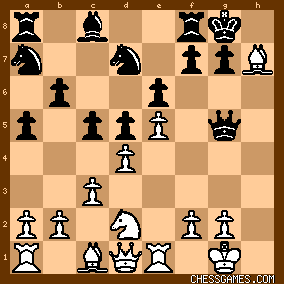
click for larger view1.  (3.39): 14...Kh8 15.Bc2 f5 16.exf6 Qxf6 17.Qh5+ Qh6 18.Qe2 Qh4 19.Nf3 Qg4 20.Qxe6 Qxe6 21.Rxe6 Rf6 22.Re8+ Rf8 (3.39): 14...Kh8 15.Bc2 f5 16.exf6 Qxf6 17.Qh5+ Qh6 18.Qe2 Qh4 19.Nf3 Qg4 20.Qxe6 Qxe6 21.Rxe6 Rf6 22.Re8+ Rf8 2.  (4.63): 14...Kxh7 15.Nf3 Qe7 16.Ng5+ Kg6 17.Qd3+ f5 18.exf6+ Kxf6 19.Nxe6 Qxe6 20.Bg5+ Kxg5 21.Rxe6 Nf6 22.Rxb6 cxd4 23.Qxd4 Bf5 24.Rb7 Nc6 25.Qb6 Rac8 26.Rxg7+ Kh6 (4.63): 14...Kxh7 15.Nf3 Qe7 16.Ng5+ Kg6 17.Qd3+ f5 18.exf6+ Kxf6 19.Nxe6 Qxe6 20.Bg5+ Kxg5 21.Rxe6 Nf6 22.Rxb6 cxd4 23.Qxd4 Bf5 24.Rb7 Nc6 25.Qb6 Rac8 26.Rxg7+ Kh6 |
|
| Jun-01-14 | | beonlychampion: I rejected Bh7+ on kh8 as I missed simple ne4 and if u saw that rest is easy. |
|
| Jun-01-14 | | patzer2: < al wazir: <patzer2: 14. Bxh7+!! Kxh7 15. Nf3> Qd8.... Not clearly stronger than the game line> You're right. I stand corrected. Also, thanks for the analysis of the mate-in-five after 14. Bxh7+!! Kxh7 15. Nf3 Qd8 16. Ng5+ Kg8 17. Qh5  . . In addition there's an interesting mate-in-four after 14. Bxh7+!! Kxh7 15. Nf3 Qd8 16. Ng5+ Kg6 (diagram below) 
click for larger view17. Qd3+ f5 (17...Kh5 18. Qh7+ Kg4 19. Qh3#; 17...Kh6 18. Qh7#) 18. exf5+ 18...Kh5 (18...Kxf6 19. Rxe6#; 18...Kh6 19. Qh7#) )19. Qh7+ Kg4 20. Qh3#. |
|
Jun-01-14
 | | LIFE Master AJ: I guessed (you really could not call it analysis, as I did not spend enough time on the problem - less than 2-3 minutes, I imagine); that 14.BxP/h7+, KxB; (if Black does not take, he is just a pawn down for nothing); 15.Nf3, (15...Ne4 looks interesting, but Black can play ...QxB/c1 and then ...fxe4; when White has a lot less attackers and Black has three minors for the lost Queen.) 15...Qd8+; 16.Ng5+, etc. ***** ***** ***** ***** ***** *****
Another reason I wanted to try the sack is:
A.) Black's pieces are very bottled up on the Q-side. B.) In some variations, White has the Rook luft Re3, to swing another piece into the attack. ***** ***** ***** ***** ***** *****
I would not bet money that the attack would win ... but I think that I would try it in a tournament game, Black's defense will be very hard. |
|
Jun-01-14
 | | Jimfromprovidence: I'm working on 14 Ne4 Qd8 15 Bg5 vs. 14 Ne4 Qd8 15 Nf6+. I do not think that the two moves are interchangeable. I believe 14 Ne4 Qd8 Bg5 wins if 15...Qc7 because of 16 Nf6+! 
click for larger viewBut it does not look like 14 Ne4 Qd8 15 Nf6+ works because black is not forced off of the d8-h4 diagonal. For example, 14 Ne4 Qd8 15 Nf6+ Nxf6 16 Bg5 Re8 looks OK for black, although the position is quite complex. 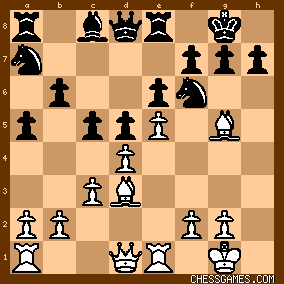
click for larger view |
|
| Jun-01-14 | | Pedro Fernandez: <<Jimfromprovidence>: For example, 14 Ne4 Qd8 15 Nf6+ Nxf6 16 Bg5 Re8 looks OK for black, although the position is quite complex.>

click for larger view
Well <Jfp> you can play 17.Bxf6! threatening the black queen, so if it moves on then 18.Qh5 threatening 19.Qxh7+, therefore 18...gxf6 19.exf6, and if 18...g6 19.Qh6 with an immediate mate in both cases. Also if 17...gxf6 18.Qg4+ followed by 19.exf6 with inevitable mate. |
|
| Jun-01-14 | | Pedro Fernandez: Further, after of 17.Bxf6! Re7 doesn't work. |
|
Jun-01-14
 | | Jimfromprovidence: < Pedro Fernandez> <Well <Jfp> you can play 17.Bxf6! threatening the black queen, so if it moves on then 18.Qh5 threatening 19.Qxh7+, therefore 18...gxf6 19.exf6, and if 18...g6 19.Qh6 with an immediate mate in both cases. Also if 17...gxf6 18.Qg4+ followed by 19.exf6 with inevitable mate.> After 14 Ne4 Qd8 15 Nf6+ Nxf6 16 Bg5 Re8 if 17 Bxf6 gxf6 18 Qg4+, then 18...Kf8 looks good for black. 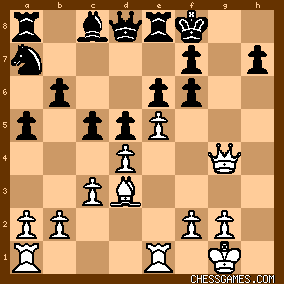
click for larger viewIf white plays 19 exf6 then 19...Qxf6.

click for larger view |
|
| Jun-01-14 | | vajeer: <Jimfromprovidence: I'm working on 14 Ne4 Qd8 15 Bg5 vs. 14 Ne4 Qd8 15 Nf6+> When I considered 14. Ne4 Qd8, I couldn't find good continuation with either 15. Nf6+ or Bg5, so I considered 15. Qg4 with intention to play Bh6 Black cannot capture knight on e4 as Qxe4 attacks rook on a8 and threatens Qxh7#. If 15...g6 then white can play 16. Bg5.
15...f5 then 16. ef6 Nxf6 17.Nxf6+ Rxf6 18. Bg5 looks good. |
|
| Jun-01-14 | | psmith: I don't think this was insane. I almost never get the Sunday puzzles. I got this one pretty quickly. |
|
| Jun-01-14 | | Madman99X: After 14. Ne4 Qd8 15. Nf6+ Nxf6 16. Bg5 Re8 Houdini plays 17. exf6, and black is in some deep doodoo. The queen threatens to come to g4 or h5, and a rook lift is also possible.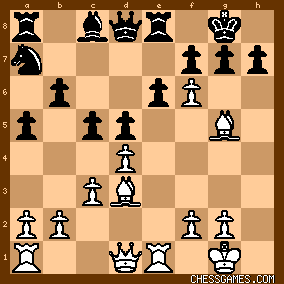
click for larger view17... gxf8 18. Bh4 Kf8 19. Qf3 where the king cannot escape to e7 for Bxf6+ is one possible grim continuation. 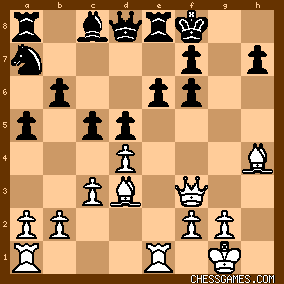
click for larger view |
|
Jun-01-14
 | | Sally Simpson: Sunday puzzels...Hard..Difficult...huh!
I have David Rudel's book 'Bxh7+' (I recall gving it a good review). All the conditons for a classical Bishop whammo on h7 are there. (Rook on f8, pawn on e6, Ng5+ will happen and Rook lifts available should you need them.) The only thing that is not often seen is the offside Black Queen on g5. 
click for larger viewBut surley all the tempo gains you get on her she will just get in the way. Bxh7+. must be right. Mind you I've never needed much encouragement to sac my dog Bishop on h7. Severe panic set in once.
Opening moves. (good gambit against the French this one - scored very well with it OTB. ) League game 1994 (and again since then both OTB and in blitz.) 1. e4 e6 2. Nf3 d5 3. e5 c5 4. b4 cxb4 5. a3 bxa3 6. Bxa3 Bxa3 7. Rxa3 Nc6 8. d4 Nge7 9. Bd3 O-O 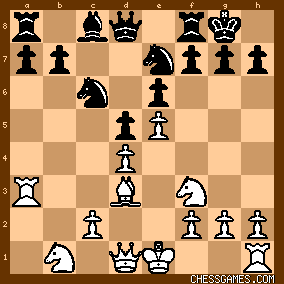
click for larger viewNo hesitation 10.Bxh7+ Kxh7 11.Ng5+ Kg6.

click for larger viewNow what? (spent a very sweaty 20 - 25 minutes on it - finally found the mate.) The lesson being if I had looked before before saccing on h7 I very much doubt I would have seen the 13th move. Sac first - think later. |
|
| Jun-01-14 | | TheBish: V Fedoseev vs J Westerberg, 2012 White to play (14.?) "Insane"
White gets a powerful attack after 14. Ne4! Qe7 (not 14...Qh4 15. Bg5, trapping the queen) 15. Nf6+!! gxf6 (or 15...Nxf6 16. Bg5, followed by 17. gxf6, and if 15...Kh8 16. Nxh7 is simple) 16. Bxh7+! Kxh7 17. Qh5+ Kg7 18. Qg4+ Kh8 19. Re3 followed by 20. Rh3#. Black can delay the end a little after 16. Bxh7+ Kg7 17. Qg4+ Kh8 18. Qh5 (and if 18...Kg7 19. Qh6+ Kh8 20. Bg6+ Kg8 21. Qh7#), but in any case the attack is winning. ~~~~~~~~~~
Interesting - I considered the bishop sac first, but decided either they were both winning (which seems to be the case) or that the knight move (14. Ne4) was slightly better. |
|
| Jun-01-14 | | patzer2: <Sally Simpson> From the last move in your game (diagram below)
click for larger viewdid you play 12. Rh3!  (mate-in-six) or 12. Rg3! (mate-in-six) or 12. Rg3!  for decisive material advantage? for decisive material advantage? |
|
Jun-01-14
 | | Richard Taylor: I found Ne4 and saw that Bxh7+ or "Greek gift sac" might be possible: but I preferred the Ne4 as it was more interesting. So I "analysed" al ther replies to it and conluded that it probably was easily winning and would have played that OTB (or Bxh7+ but one has to decide which lines to analyse). I won a game with a sac on f6 so I was interested more in the Ne4 plan. There seems to be more than one way to win which is not uncommon. I saw a few ways to win in a number of variations.
I knew this was a Tarrasch as I play it and in fact have faced the Guimard a few times. Black went wrong getting his Q to g5 So Ne4 seems to work o.k. or at least it did work which is the main thing. Black is a little better trying Qd8 rather than Qe7, as in one line W can threaten mate while pinning the f pawn, but it is still lost. |
|
| Jun-02-14 | | M.Hassan: "Insane"
White to play 14.?
14.Ne4 Qe7
15.Nf6+ if gxf6
16.Qg4+ Kh8
17.Qh4 threatening mate on h7
17..........f5
18.Qxe7
Black Queen is lost
I did not work out the other variation
15.Nf6+ Nxf6 due to shortage of time. |
|
Jun-02-14
 | | Richard Taylor: This was a better problem than I realised. My "analysis" was wrong as I went on one track, forgetting to analyse 1. Bxh7+ which I now see on my chess computer is a better move. But 1. Ne4 is less clear although I felt White would be able to win. The "Greek gift" here was hard to see for me I think because of the Black Queen's location on g4 which prevented (I think for psychological-visual reasons) attention to Bxh7+ especially as the attacking or "springer" N is also usually on f3. I also miscalculated some of the winning moves in the 1. Ne4 line but the necessity of finding some of the winning lines (that I did see) was a good exercise. For those who all solved this or found the right procedure - congratulations! |
|
Jun-02-14
 | | Sally Simpson: Hi Patzer2,

click for larger viewYes 12.Rh3 which I discarded right away due to 12...Rh8. I went back to it because I did not like anything else. Then...eventually I found 13.Nh7! 12.Rh3 Rh8. 13.Nh7
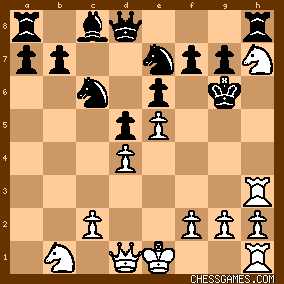
click for larger viewAs I said, I know me and if I had analysed before the sac instead of trusting my intuition (which a lot players never do and miss these things) I know I would never have seen 13.Nh7. "...trusting my intuition."
I have a theory that when your opponent makes a move which was not expected. Experienced players will see a reply within 5-10 seconds. That is very often the move they will play. (I'd put the figure at 7 times out of 10). You of course have to spend time looking at the position in case it may be a 3 from 10 move but the move chosen is very often the first instant thought. |
|
Jun-03-14
 | | al wazir: <patzer2>: Surely this game of <Sally Simpson>'s is a good argument against your "sham sacrifice" terminology. She didn't calculate that 10. Bxh7+ Kxh7 was a forced win (though it is). She gave up the ♗ speculatively, on intuition. It was a *real* sacrifice. Some sacrifices bring a forced win that takes ten moves or more. Sometimes it takes a computer running a sophisticated chess program to prove they're right. GMs can analyze the consequences of a move much better than ordinary mortals, but they often make winning sacs without fully calculating the outcome, based largely on intuition. If every sac that leads to a forced win is a "sham," then a non-sham sacrifice can only refer to one that's unsound. |
|
 |
|
< Earlier Kibitzing · PAGE 2 OF 2 ·
Later Kibitzing> |





